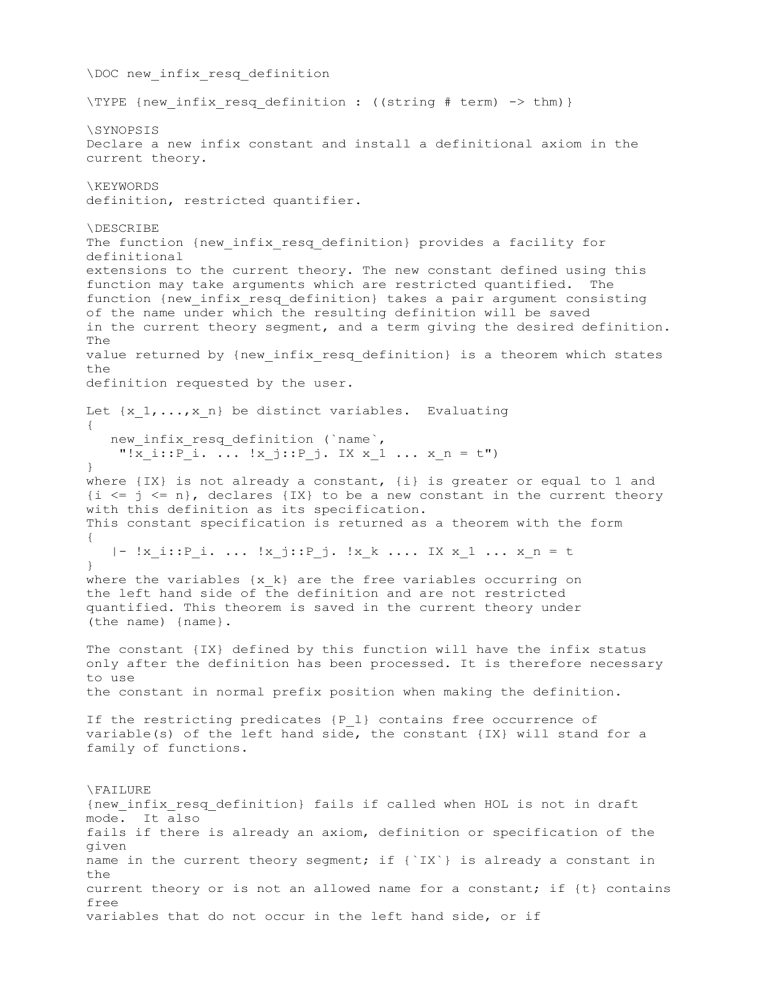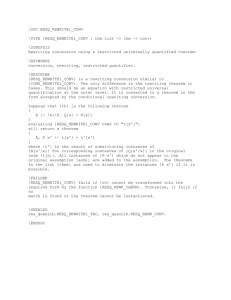new_infix_resq_definition.doc

\DOC new_infix_resq_definition
\TYPE {new_infix_resq_definition : ((string # term) -> thm)}
\SYNOPSIS
Declare a new infix constant and install a definitional axiom in the current theory.
\KEYWORDS definition, restricted quantifier.
\DESCRIBE
The function {new_infix_resq_definition} provides a facility for definitional extensions to the current theory. The new constant defined using this function may take arguments which are restricted quantified. The function {new_infix_resq_definition} takes a pair argument consisting of the name under which the resulting definition will be saved in the current theory segment, and a term giving the desired definition.
The value returned by {new_infix_resq_definition} is a theorem which states the definition requested by the user.
Let {x_1,...,x_n} be distinct variables. Evaluating
{
new_infix_resq_definition (`name`,
"!x_i::P_i. ... !x_j::P_j. IX x_1 ... x_n = t")
} where {IX} is not already a constant, {i} is greater or equal to 1 and
{i <= j <= n}, declares {IX} to be a new constant in the current theory with this definition as its specification.
This constant specification is returned as a theorem with the form
{
|- !x_i::P_i. ... !x_j::P_j. !x_k .... IX x_1 ... x_n = t
} where the variables {x_k} are the free variables occurring on the left hand side of the definition and are not restricted quantified. This theorem is saved in the current theory under
(the name) {name}.
The constant {IX} defined by this function will have the infix status only after the definition has been processed. It is therefore necessary to use the constant in normal prefix position when making the definition.
If the restricting predicates {P_l} contains free occurrence of variable(s) of the left hand side, the constant {IX} will stand for a family of functions.
\FAILURE
{new_infix_resq_definition} fails if called when HOL is not in draft mode. It also fails if there is already an axiom, definition or specification of the given name in the current theory segment; if {`IX`} is already a constant in the current theory or is not an allowed name for a constant; if {t} contains free variables that do not occur in the left hand side, or if
any variable occurs more than once in {x_1, ..., x_n}. Finally, failure occurs if there is a type variable in {x_1}, ..., {x_n} or {t} that does not occur in the type of {IX}.
\EXAMPLE
A function for indexing list element starting from 1 can be defined as follows:
{
#let IXEL1_DEF = new_infix_resq_definition (`IXEL1_DEF`,
# "!n:: (\k. 0 < k). IXEL1 n (l:* list) = EL (n -1) l");;
IXEL1_DEF = |- !n :: \k. 0 < k. !l. IXEL1 n l = EL(n - 1)l
}
One can then use {IXEL1} as an infix and do the following proof:
{
#g"2 IXEL1 [1;2;3] = 2";;
"2 IXEL1 [1;2;3] = 2"
#e(RESQ_REWRITE1_TAC IXEL1_DEF THENL[
# CONV_TAC(ONCE_DEPTH_CONV num_CONV) THEN MATCH_ACCEPT_TAC LESS_0;
# CONV_TAC((LHS_CONV o LHS_CONV)(REDEPTH_CONV num_CONV))
# THEN REWRITE_TAC[SUB_MONO_EQ;SUB_0;EL;HD;TL]]);;
OK..
goal proved
|- 2 IXEL1 [1;2;3] = 2
Previous subproof:
goal proved
() : void
}
\SEEALSO new_binder_resq_definition, new_resq_definition, new_definition, new_specification.
\ENDDOC
